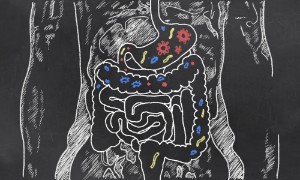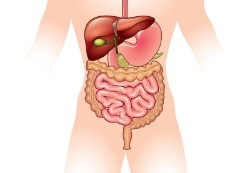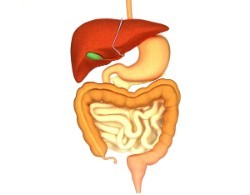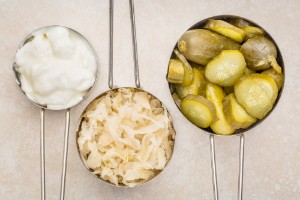What role do enzymes play in human digestion and metabolism
 Digestion is an extremely complex process, which consists in splitting food particles and their subsequent assimilation. One of the main functions in the processing of proteins, fats, carbohydrates and other substances is assigned to enzymes – special protein molecules capable of significantly accelerating the rate of chemical reactions.
Digestion is an extremely complex process, which consists in splitting food particles and their subsequent assimilation. One of the main functions in the processing of proteins, fats, carbohydrates and other substances is assigned to enzymes – special protein molecules capable of significantly accelerating the rate of chemical reactions.
Under certain conditions (the course of infectious, inflammatory and somatic diseases, malnutrition, poisoning with toxic and poisonous substances), the activity of enzymes is inhibited, which leads to all kinds of disorders.
In this article, we will look at what enzymes are and what their role is in digestion and other metabolic processes in the human body.
Content
What are digestive enzymes?
 Digestive enzymes are protein molecules that break down food particles that have entered the human body into simpler substances that can be absorbed through the intestinal wall.
Digestive enzymes are protein molecules that break down food particles that have entered the human body into simpler substances that can be absorbed through the intestinal wall.
Enzyme secretion is an extremely complex mechanism, the work of which is influenced by many factors: diet, the condition of various parts of the gastrointestinal tract, the course of various diseases.
The main areas of enzyme functioning are the oral cavity, stomach and small intestine.
Salivary glands, pancreas, as well as small secretory cells located in the thickness of the mucous membrane play an active part in the synthesis and release of protein particles stomach and of the intestine .
Scientists identify the following main types of enzymes:
- Proteases or peptidases. Are responsible for the breakdown of proteins into amino acids or short peptides.
- Lipase. Break down any fats to fatty acids and glycerin.
- Nucleases. Are necessary for the decomposition of nucleic acids to simple bases.
- Carbohydrases. Provide hydrolysis of carbohydrates (starch, simple and complex sugars).
Their role in food digestion
 Enzymes play an important biological role in the metabolism of the body and, first of all, in the digestion of food. With their lack or absence, the full assimilation of all nutrients is almost impossible.
Enzymes play an important biological role in the metabolism of the body and, first of all, in the digestion of food. With their lack or absence, the full assimilation of all nutrients is almost impossible.
Digestion of food begins in the oral cavity. Salivary glands secrete amylase– an enzyme of saliva, which, in the process of chewing food, breaks down starch to soluble sugars (maltose, dextrins, maltriose).
The second stage of digestion is processing with gastric enzymes. The main enzyme that works in the stomach is pepsin. It breaks the peptide bonds of high molecular weight proteins, resulting in the formation of peptides.
Pancreatic juice enzymes are active in the lumen of the duodenum. Secretion occurs through a large papilla that opens in the wall of the intestine.
The following classification of pancreatic (pancreatic) enzymes is distinguished:
- Proteases. Are divided into trypsin (acts similarly to pepsin), chymotrypsin (cleaves proteins of animal and plant foods), carboxypeptidase, elastase (hydrolyze elastin).
- Nucleases. Break the bonds between DNA and RNA strands.
- Steapsin. Provides the breakdown of fats.
- Amylase. Destroys starch and glycogen, contributing to the formation of simple carbohydrate particles.
- Lipase. It mainly affects fats, which are released into the lumen of the gastrointestinal tract along with bile. It has a tropicity to triacylglycerides.
Food, getting into the loops of the small intestine, is exposed to an even more massive list of enzymatic substances, among which there are:
- Peptidases. Enteropeptidase promotes the activation of trypsinogen (which has been isolated by the pancreas), resulting in the formation of trypsin, which cleaves high-molecular proteins and peptides. The peptidase group also includes alanine aminopeptidase, which destroys sulfide bonds in peptides formed after exposure to gastric juice proteases.
- Lipase.
- Erepsin (hydrolyzes proteins).
- Enzymes that destroy disaccharide formations to monosaccharides. Sucrose breaks down sucrose to form glucose and fructose, maltase – maltose to glucose, isomaltase – maltose and isomaltose (maltose isomer) to glucose, lactase – lactose to galactose and glucose.
Microorganisms living in the human large intestine secrete digestive enzymes that help digest certain food options. Lactobacilli, bifidobacteria and E. coli (belongs to the family of enterobacteria) have the greatest effectiveness.
American studies have found that an increase in the population of lacto- and bifidobacteria in the microflora of the gastrointestinal tract increases the rate of lactose digestion.
It is important to note that according to scientists , people with lactose intolerance (up to 25% of the world's population suffers from this pathology in varying degrees of severity) can safely consume up to 18 g of lactose.
Scientists recommend Include probiotic drugs and foods to improve food digestion.
In separate articles we have reviewed, What are probiotics? , and described their 8 useful properties .
5 main factors affecting their work
 Enzymes are extremely fastidious substances that require certain conditions for the full realization of their functions.
Enzymes are extremely fastidious substances that require certain conditions for the full realization of their functions.
The key factors regulating the work of enzymes include:
- Body temperature. Normally, a body temperature of 37 degrees is maintained in the lumen of the gastrointestinal tract. A decrease (in case of hypothermia) or an increase (against the background of infectious and inflammatory diseases) of this indicator slows down the activity of enzymes and disrupts the absorption of food. In addition, an increase in body temperature provokes the denaturation of protein molecules of enzymes, as a result of which their work is completely stopped.
- Acidity. An acidic environment is constantly maintained in the stomach, and an alkaline one in all other parts of the digestive system. The use of too acidic foods, dysbiosis and other disorders that can affect the pH, inhibit the work of enzymes.
- Inflammatory diseases. Many pathologies (pancreatitis, duodenitis, hepatitis), etc. can cause a violation of enzyme secretion. Against the background of a decrease in the number of enzymes in the intestine, the course of food fermentation processes slows down significantly.
- The quality and balance of the diet. Excessive consumption of certain types of foods (proteins, fats or carbohydrates) provokes an increased load on some enzymes and reduces it on others. As a result, adequate splitting of food particles becomes impossible. The use of indigestible foods in the diet also slows down the breakdown of nutrients. For example, according to scientists , excessive consumption of cellulose (found in ice cream, certain types of cheese and bread) reduces the activity of carbohydrate enzymes several times.
- Sending toxic substances. This group includes disconnectors of energy metabolism (they slow down the synthesis of energy molecules &8212; ATP and ADP) and inhibitors of protein synthesis (for example, mustard gas). Such poisons are not common in everyday life, but can be used in military operations.
Causes and symptoms of deficiency
 Various diseases of the digestive system lead to enzyme deficiency.
Various diseases of the digestive system lead to enzyme deficiency.
The most important organ for maintaining the processes of assimilation of food is the pancreas. Unfortunately, up to 27% of the population has problems with this organ. The most common pathologies include: chronic and acute pancreatitis, cystic fibrosis, pancreatic cancer. 7 foods that are good for the pancreas , see in a separate article.
Exacerbations of chronic deviations from the digestive tube (chronic gastritis and duodenitis, biliary dyskinesia, cholecystitis) are in second place in frequency.
The first symptoms of digestive enzyme deficiency are usually:
- Heartburn and belching;
- Flatulence (excessive formation of gas in the intestinal lumen);
- Stool disorders by type of diarrhea or constipation;
- Spastic pain in any part of the abdomen;
- General weakness, chronic fatigue , drowsiness, decrease working capacity .
If the above symptoms appear, it is recommended to consult a doctor.
How can digestion be improved
 First of all, it is important to change your diet and add to it foods that are good for digestion
.
First of all, it is important to change your diet and add to it foods that are good for digestion
.
First of all , should be included in the daily menu Probiotic-rich foods (live bacteria):
- Fermented dairy products (especially kefir and yogurt);
- Sauerkraut;
- Pickles;
- Apple cider vinegar;
- Other fermented foods.
Secondly , you should eat more prebiotic products , namely vegetables and fruits that have not been heat-treated (avocado, mango, papaya, grain shoots, garlic and horseradish). Prebiotic foods are rich in indigestible fiber, which is food for beneficial bacteria.
Enzymes can also be obtained using various medications and dietary supplements (Pancreatin, Creon, Festal, Panzinorm, Oraza, etc.).
Conclusion
Thus, enzymes play a crucial role in the process of splitting and assimilation of food particles. They can be obtained by consuming individual food groups, as well as using medications.





